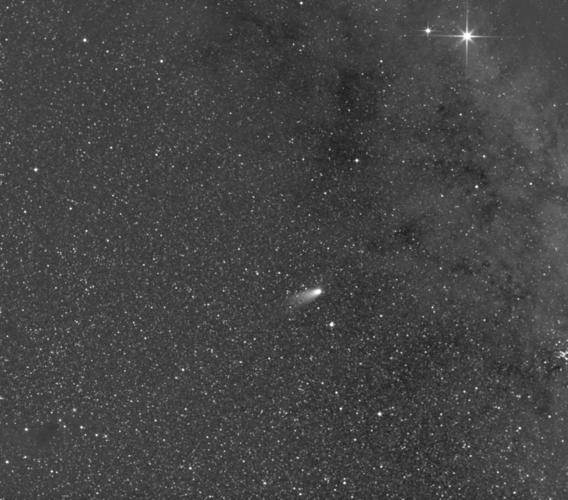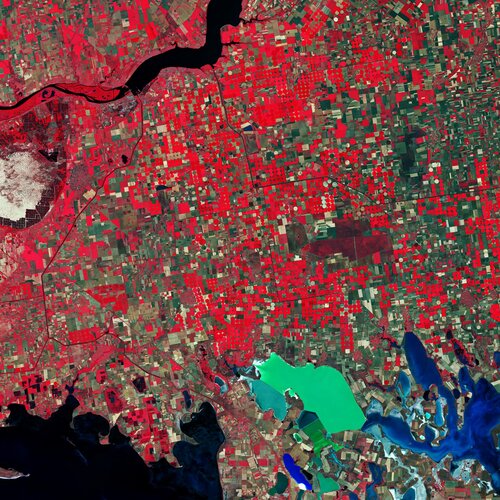
Copernical Team
A Christmas comet for Solar Orbiter

Comet Leonard, a mass of space dust, rock and ice about a kilometre across is heading for a close pass of the Sun on 3 January, and the ESA/NASA Solar Orbiter spacecraft has been watching its evolution over the last days.
2022 Copernicus Sentinels calendar

Download the 2022 Copernicus Sentinels calendar
Deep Mantle Krypton Reveals Earth's Outer Solar System Ancestry
 Krypton from the Earth's mantle, collected from geologic hot spots in Iceland and the Galapagos Islands, reveals a clearer picture of how our planet formed, according to new research from the University of California, Davis.
The different isotopes of krypton are chemical fingerprints for scientists sleuthing out the ingredients that made the Earth, such as solar wind particles and meteorit
Krypton from the Earth's mantle, collected from geologic hot spots in Iceland and the Galapagos Islands, reveals a clearer picture of how our planet formed, according to new research from the University of California, Davis.
The different isotopes of krypton are chemical fingerprints for scientists sleuthing out the ingredients that made the Earth, such as solar wind particles and meteorit New technologies make Chinese astronauts' in-orbit lives easier
 Chinese astronauts live and work more conveniently and comfortably in orbit with the application of advanced information technology, said the China Aerospace Science and Technology Corporation (CASC).
There are smart home systems in China's space station core module Tianhe, Bai Linhou, deputy chief designer of the space station at the China Academy of Space Technology (CAST) under the CASC
Chinese astronauts live and work more conveniently and comfortably in orbit with the application of advanced information technology, said the China Aerospace Science and Technology Corporation (CASC).
There are smart home systems in China's space station core module Tianhe, Bai Linhou, deputy chief designer of the space station at the China Academy of Space Technology (CAST) under the CASC Fugro's remote space operations complex to be located in Perth, Australia
 Fugro confirms the Australian Space Automation, Artificial Intelligence and Robotics Control Complex (SpAARC) will be located in the heart of downtown Perth's central business district (CBD). Housed in Western Australia's (WA's) largest telecommunications exchange, and thanks to an ongoing partnership with Telstra, Fugro's world-class facility will manage robotics and remote operations in Austra
Fugro confirms the Australian Space Automation, Artificial Intelligence and Robotics Control Complex (SpAARC) will be located in the heart of downtown Perth's central business district (CBD). Housed in Western Australia's (WA's) largest telecommunications exchange, and thanks to an ongoing partnership with Telstra, Fugro's world-class facility will manage robotics and remote operations in Austra Kacific goes all-in on AWS to scale up delivery of its broadband internet
 Kacific Broadband Satellites has announced that it is going all-in on Amazon Web Services (AWS) to scale up the delivery of its broadband internet for the rural regions of Southeast Asia and the Pacific. Kacific plans to migrate its IT infrastructure and critical business applications to AWS by 2022.
AWS has enabled Kacific to reduce time-to-market and to enhance network management by appr
Kacific Broadband Satellites has announced that it is going all-in on Amazon Web Services (AWS) to scale up the delivery of its broadband internet for the rural regions of Southeast Asia and the Pacific. Kacific plans to migrate its IT infrastructure and critical business applications to AWS by 2022.
AWS has enabled Kacific to reduce time-to-market and to enhance network management by appr SPAINSAT NG program successfully passes Critical Design Review
 The SPAINSAT NG programme has successfully passed another important milestone, the critical design review (CDR) of the payload and the complete satellite, including the CDR elements of the Pacis 3 partnership project with the European Space Agency (ESA). The review was declared successful after verifying the good progress of the tests performed on the development models of the X-band payload.
The SPAINSAT NG programme has successfully passed another important milestone, the critical design review (CDR) of the payload and the complete satellite, including the CDR elements of the Pacis 3 partnership project with the European Space Agency (ESA). The review was declared successful after verifying the good progress of the tests performed on the development models of the X-band payload. Research into ageing set to blast into space
 Scientists at the University of Liverpool, funded by the UK Space Agency, are using space to understand what happens to human muscles as we age, and why.?
When astronauts spend time in space, without the effects of gravity, their muscles get weaker, just as they do in older age, before recovering when they return to Earth. By studying what happens to muscle tissue in space, the team can co
Scientists at the University of Liverpool, funded by the UK Space Agency, are using space to understand what happens to human muscles as we age, and why.?
When astronauts spend time in space, without the effects of gravity, their muscles get weaker, just as they do in older age, before recovering when they return to Earth. By studying what happens to muscle tissue in space, the team can co Dragon delivery - European science destined for space
 The next SpaceX resupply vehicle is packed with European science, ready for delivery to the International Space Station just in time for Christmas.
The Dragon spacecraft is scheduled to launch from NASA's Kennedy Space Center in Florida, USA, at 11:06 CET (10:06 GMT) Tuesday 21 December. But before it does, we take a quick peek at some of the European cargo it carries.
b>Safe air br
The next SpaceX resupply vehicle is packed with European science, ready for delivery to the International Space Station just in time for Christmas.
The Dragon spacecraft is scheduled to launch from NASA's Kennedy Space Center in Florida, USA, at 11:06 CET (10:06 GMT) Tuesday 21 December. But before it does, we take a quick peek at some of the European cargo it carries.
b>Safe air br A gigantic lane made of raw material for new stars
 A group of astronomers, led by researchers from the Max Planck Institute for Astronomy (MPIA), have identified one of the longest known structures in the Milky Way. It stretches some 3900 light-years and consists almost entirely of atomic hydrogen gas. This filament, called "Maggie", could represent a link in the matter cycle of the stars. Analysing the measurements suggests that the atomic gas
A group of astronomers, led by researchers from the Max Planck Institute for Astronomy (MPIA), have identified one of the longest known structures in the Milky Way. It stretches some 3900 light-years and consists almost entirely of atomic hydrogen gas. This filament, called "Maggie", could represent a link in the matter cycle of the stars. Analysing the measurements suggests that the atomic gas 
































